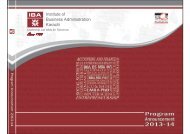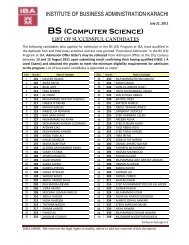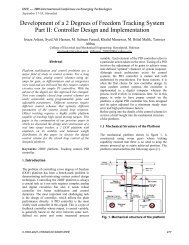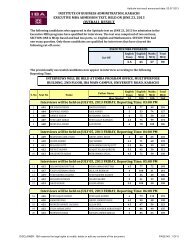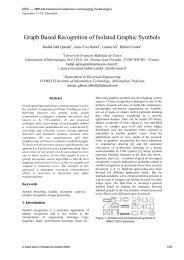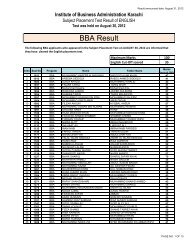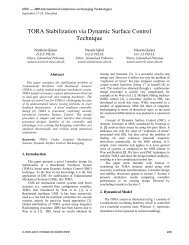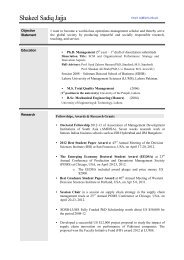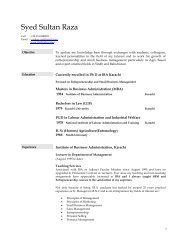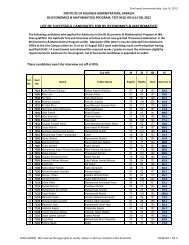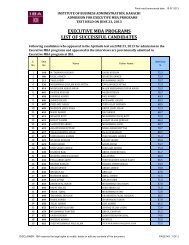Sadia Iqbal, Arshad Iqbal
Sadia Iqbal, Arshad Iqbal
Sadia Iqbal, Arshad Iqbal
- No tags were found...
You also want an ePaper? Increase the reach of your titles
YUMPU automatically turns print PDFs into web optimized ePapers that Google loves.
IEEE --- 2005 International Conference on Emerging TechnologiesSeptember 17-18, Islamabad<strong>Sadia</strong> <strong>Iqbal</strong>Fatima Jinnah Women UniversityThe Mall, Rawalpindi, Pakistan<strong>Sadia</strong>qur@hotmail.comABSTRACTAlthough there have been a number of Quality ofService (QoS) routing protocols already proposed forthe Mobile Ad Hoc Networks (MANETs), they share theidea that one route should be selected out of allavailable routes based on optimizing some parameterslike delay, throughput or packet loss ratio. In thispaper, Six State Routing Model (SSRM) has beenproposed for QoS through real time traffic support inMANETs. In MANETs, one hop and two hopneighborhood links break frequently due to topologyupdates and transmission range, which require realtime recovery. SSRM addresses the key issues likefrequent topology update, transmission range and sleepmode by introducing different states of nodes andswitching from one state to other takes place throughoptimization criteria such as throughput and reliability.All nodes existing in SSRM perform effective routingdiscovery through proactive local route informationupdates. This will provide reliability of communicationby reducing packet loss ratio and increasing packetdelivery ratio in highly dynamic mobile ad hocnetworks.Keywords: Ad hoc networks; Six state routing model;unidirectional links; Transient topology disturbance;Transitions.1. IntroductionMobile ad hoc networks consist of mobilenodes providing a dynamic autonomous network.Recently, mobile ad hoc computations haveattracted researchers because of new radiotechnology, rapid deployment anytime andanywhere but without wired based stations. Adhoc networks have a wide application incommercial and especially in defense areas e.g. ina battlefield without any administrative support.U.S. Defense Research Agency DARPA initiatesthis technology during their work on Packet RadioNetworks (PRNET) [1] and Survivable AdaptiveNetworks (SUSPAN) [2]. Mobile ad hoc networksare self-creating, self-organizing and selfadministrating[3]. Due to frequent topology<strong>Arshad</strong> <strong>Iqbal</strong>CIS DEPTT, PIEASNILORE, Islamabad, Pakistanarshad_mscs@yahoo.comupdates, battery power consumption and lack ofbandwidth, MANETs becomes a topic of activeresearch area.Traditional Routing protocols in packetswitchednetworks are mostly based on eitherdistance vector or link-state routing algorithms.Both routing protocols are designed for statictopology with bi-directional links and thereforemay have problems to converge to a steady statewith frequently changing topology. Also bothalgorithms allow a node to find the next hopneighbor to reach the destination via the "shortestpath". In MANETs, fast moving nodes, whiletraversing a relatively stable ad hoc network,create transient fluctuations in neighbor androuting tables of nearby nodes due to dynamicadaptability of topology changes. Network nodesmust update routing/neighbor tables immediatelyand appropriately to reflect frequent topologyupdates. Ad hoc networks usually suffer fromtransient fluctuations due to dynamic, numerous,complex and relatively unpredictable topologychanges. Also nodes may move in randomdirections with random speeds and during theirmovement, routing and neighbor tables of nearbynodes change. It is also possible that a routealready configured according to QoS constraints,may no longer exists due to transient behavior ofnodes. Therefore, routing protocols must takeintelligent and real time decisions through someQoS routing model to maintain transient routes.The rest of the paper is organized as follows:Section 2 surveys previous work done. Section 3reviews the OLSR protocol; Section 4 presents themechanism & parameters used to develop SSRM;Section 5 presents different states in SSRM. Theconclusions are presented in Section 6.2. Related WorkS. Chen and K. Nahrstedt [11] proposed adistributed QoS routing scheme; ticket based0-7803-9247-7/05/$20.00 ©2005 IEEE80
IEEE --- 2005 International Conference on Emerging TechnologiesSeptember 17-18, Islamabadprobing for mobile nodes that selects a networkpath with sufficient resources to satisfy a certaindelay (or bandwidth) requirement in a dynamicmultihop mobile environment.Y. Dong, T. Yang, D. Makrakis and I.Lambadris [13] investigated quality of service inmobile ad hoc networks through super nodes.They proposed QoS by maintaining virtual routediscovery, reverse link labeling and dynamic routerepairing. They also investigated QoS byincorporating mobility of nodes in mobile ad hocnetworks. Their results showed that their proposedtechnique is performing well in the context ofpacket delivery ratio and average end-to-end delayby having a compromise on control overhead.Some recent algorithms were proposed by R.Guerin, A. Orda [14] to work with impreciseinformation (e.g., the probability distribution oflink delay). But they require the preciseinformation about the network topology, which isnot available in an ad hoc network. Secondly,nodes may join, leave, and rejoin an ad hocnetwork at any time and any location.P. Sinha, R. Sivakumar, and V. Bharghanan[10] proposed a QoS protocol for ad hocnetworks; core-extraction distributed ad hocrouting algorithm (CEDAR) providing on-demandrouting. Concerning to QoS issues in MANETs,proactive protocol provides good support to takereal time decisions on unpredictable topologyupdates and battery levels. Although in CEDAR,overhead is reduced due to decrease in number ofnodes participating in route computations butrouting information depends on pre-known QoSrequirements and becomes too slow especially fordense highly mobile networks. N. Nikaein, C.Boneet [15] proposed a cross layer quality ofservice model to support adaptively andoptimization across multiple layers of protocolsfor Internet and manets. They suggested QoSmetrics as application layer metrics, networkslayer metrics and MAC layer metrics.J. Xue, P. Stuedi, and G. Alonso [16]proposed an adaptive Reservation and PreallocationProtocol (ASAP) protocol for mobile adhoc networks through two signaling messages: SRand HR. ASAP protocol encounters mobilityenvironments, while technique proposed in thispaper includes mobility models as well as batterypowers. L. Donatiello, and M. Furini [17]proposed a WRT-Ring protocol with QoSprovision by means of timing guarantees in ad hocnetworks. Briefly, WRT-ring protocol providesbetter network performance through delaybounded services in a shorter time but anybandwidth allocation scheme has not beenconsidered during analysis.3. Review of OLSRThe Optimized Link State Routing (OLSR)protocol for mobile ad hoc networks is anoptimization of the classical link state algorithmtailored to the requirements of a mobile wirelessLAN. It operates as a table driven, proactiveprotocol, i.e., exchanges topology informationwith other nodes of the network regularly. Thekey concept used in the protocol is that ofmultipoint relays (MPRs) [12]. MPRs are selectednodes, which forward broadcast messages duringthe flooding process. This technique substantiallyreduces the message overhead as compared to aclassical flooding mechanism, where every noderetransmits each message when it receives the firstcopy of the message. In OLSR, only nodeselected as MPRs generate link state information.Thus, a second optimization is achieved byminimizing the number of control messagesflooded in the network. As a third optimization,an MPR node may choose to report only linksbetween itself and its MPR selectors. Hence, ascontrary to the classic link state algorithm, partiallink state information is distributed in thenetwork. This information is then used for routecalculation. OLSR provides optimal routes (interms of number of hops). The protocol isparticularly suitable for large and dense networksas the technique of MPRs works well in thiscontext. This Information is then used by theOLSR protocol for route calculation. As aconsequence, the routes contain only the MPRs asintermediate nodes from a source to a destination.4. Proposed MechanismsIn mobile ad hoc networks, nodes may havedifferent behavior with respect to updates in onehop and two hop neighbors. Also routing pathmay vary due to usage of battery or some otherhidden problem. Following approach is suggestedfor quality of service in MANETs. FMN_SENSE[18] parameter is the basic parameter to decide thenode mobility and it is given as:81
IEEE --- 2005 International Conference on Emerging TechnologiesSeptember 17-18, IslamabadFMN _ SENSE= y z{ , }................(1)The format of every “HELLO” packet havingx + y x + ythree bits in its reserved part is shown in Figure 2.Where ‘x’ is the number of nodes currentlydeclared as one-hop neighbors in neighbor tableof a node. ‘y’ is the number of new nodes addedas one hop neighbors in neighbor table of a nodeand ‘z’ is the number of nodes removed from theneighbor table which remained at one hopneighbors in routing tables for the previous timeinterval for a node.Four mobility models are suggested to handletransient fluctuations depending uponFMN_SENSE parameter and those are STATIC,STABLE, UNSTABLE and UNRELIABLEmobility models. In the proposed approach,transient behavior of a node depends onFMN_SENSE value and mobilities are brieflysummarized in the Table with [18]):Table 1: FMN_SENSE values for four mobility modelsMobilityFMN_SENSEOther LimitationsModelSTATIC Less than 0.33 Static relative to each otherSTABLE Less than 1 but greaterthan or equal to 0.33Dynamics are within upper andlower control layers.UNSTABLE Less than 1 but greaterthan or equal to 0.33Dynamics are out of range of upperand control layers.UNRELIABLE Less than 1 Changing mobility model frequentlyFrom above table, low and high mobilities can beextracted as:Low Mobility FMN_SENSE < 0.66High Mobility FMN_SENSE >=0.66Also three bits are proposed battery power bit(BPB), fast moving node bit (FMB) and sleepmode bit (SMB). All these bits are associated inevery “HELLO” and “TC” packet in MANETsshown below. Link Sensing, neighbor detectionand MPR signaling is accomplished throughperiodic emission of HELLO messages over theinterfaces through which connectivity is checkedwhile TC-messages perform the task of topologydeclaration [12]. The proposed format of a TCmessage including three bits (shaded) is shown inFigure 1.0 1 2 30 1 2 3 4 5 6 7 8 9 0 1 2 3 4 5 6 7 8 9 0 1 2 3 4 5 6 7 8 9 0 1+-+-+-+-+-+-+-+-+-+-+-+-+-+-+-+-+-+-+-+-+-+-+-+-+-+-+-+-+-+-+-+-+| ANSN | Reserved |+-+-+-+-+-+-+-+-+-+-+-+-+-+-+-+-+-+-+-+-+-+-+-+-+-+-+-+-+-+-+-+-+| Advertised Neighbor Main Address |+-+-+-+-+-+-+-+-+-+-+-+-+-+-+-+-+-+-+-+-+-+-+-+-+-+-+-+-+-+-+-+-+| Advertised Neighbor Main Address |+-+-+-+-+-+-+-+-+-+-+-+-+-+-+-+-+-+-+-+-+-+-+-+-+-+-+-+-+-+-+-+-+| ... |+-+-+-+-+-+-+-+-+-+-+-+-+-+-+-+-+-+-+-+-+-+-+-+-+-+-+-+-+-+-+-+-+Figure 1: Proposed TC packet format0 1 2 30 1 2 3 4 5 6 7 8 9 0 1 2 3 4 5 6 7 8 9 0 1 2 3 4 5 6 7 8 9 0 1+-+-+-+-+-+-+-+-+-+-+-+-+-+-+-+-+-+-+-+-+-+-+-+-+-+-+-+-+-+-+-+-+| Reserved | Htime | Willingness |+-+-+-+-+-+-+-+-+-+-+-+-+-+-+-+-+-+-+-+-+-+-+-+-+-+-+-+-+-+-+-+-+| Link Code | Reserved | Link Message Size |+-+-+-+-+-+-+-+-+-+-+-+-+-+-+-+-+-+-+-+-+-+-+-+-+-+-+-+-+-+-+-+-+| Neighbor Interface Address |+-+-+-+-+-+-+-+-+-+-+-+-+-+-+-+-+-+-+-+-+-+-+-+-+-+-+-+-+-+-+-+-+| Neighbor Interface Address |+-+-+-+-+-+-+-+-+-+-+-+-+-+-+-+-+-+-+-+-+-+-+-+-+-+-+-+-+-+-+-+-+: . . . : : :+-+-+-+-+-+-+-+-+-+-+-+-+-+-+-+-+-+-+-+-+-+-+-+-+-+-+-+-+-+-+-+-+| Link Code | Reserved | Link Message Size |+-+-+-+-+-+-+-+-+-+-+-+-+-+-+-+-+-+-+-+-+-+-+-+-+-+-+-+-+-+-+-+-+| Neighbor Interface Address |+-+-+-+-+-+-+-+-+-+-+-+-+-+-+-+-+-+-+-+-+-+-+-+-+-+-+-+-+-+-+-+-+| Neighbor Interface Address |+-+-+-+-+-+-+-+-+-+-+-+-+-+-+-+-+-+-+-+-+-+-+-+-+-+-+-+-+-+-+-+-+: :: :(etc.)Figure 2: Proposed HELLO packet formatTaking BPB, FMB and SMB bits into account,each combination falls into one of six states,presented in Table 2.Table 2: Bits combinations for six state routing modelValues of BitsStateBPB FMB SMB0 0 0 Highly Stable State (HSS)0 0 1 Silent Stable State (SSS)1 0 1 Unidirectional but Silent State (USS)1 0 0 Unidirectional but Active State (UAS)0 1 0 Transient but Active State (TAS)1 1 0 Unidirectional but Transient State(UTS)Total number of eight combinations exists fromwhich two combinations {0,1,1} and {1,1,1} arenot possible because node in transient mode withasymmetric links cannot be in sleep mode at all.Initialize three bits equal to 0{Beginning at the new joining of a node, assign three bitsequal to {0, 0, 0} showing highly stable state.If any change encounters in default combination of bits,perform the following:{If node is in sleep mode, change SMB to 1, otherwise to 0.If node mobility (FMN_SENSE) is equal to or greater than66%, change FMB to 1, otherwise to 0.If battery power reduces than a threshold value (50%),change BPB to 1, otherwise to 0.}Switch to some other state if combination allows.Repeat above steps proactively.}Figure 3:Algo for dynamic 3-bits combination in HELLO & TC packets82
IEEE --- 2005 International Conference on Emerging TechnologiesSeptember 17-18, IslamabadA node transmitting and receiving HELLOpackets, TC packets, MID packets and HNApackets [12] always exist in active state to senseits neighborhood proactively. Such nodes cannotbe in sleep mode. HELLO message and TCmessage are transmitted throughout in the networkproactively and each node analyzes packetsreceived by it. Different combination occurred inHELLO and TC messages as described in thealgorithm in Figure 3.5. Six State Routing ModelAs communication proceeds in MANETs,nodes already connected to network through theirone hop and two hop neighborhoods may changetheir point of attachment relative to their previousneighborhood, may connect, leave, and reconnectan ad hoc network at any time and any location. Asmart QoS framework must exist to control thebehavior of mobile nodes during and aftertransitions. Also unidirectional links may exist inMANETs in a network due to a number of reasonslike transmission range, transmission media and anumber of other reasons. A network behaves likea very complex networks if it has very mobile aswell as low battery power nodes. Also the searchof a good path for a new connection that does notdestroy the quality of service of existingconnections is a NP-hard problem. For real timerecoveries or routing paths, it is very important toidentify the state of a node, which provides logicalorganization of the complete network. Forexample a node may fluctuate from one state toother depending upon the parameters likestability, link status and sleep mode. Theseparameters have a strong impact on the overallperformance of MANETs.As the dynamic nature of an ad hoc networkmakes the available state information inherentlyimprecise, Six State Routing Model logicallypartitions the complete ad hoc network intodifferent distinct states. Also a node can exist intoa unique state at a certain current time T c . Themodel also addresses the dynamic behavior ofnodes in real time and immediately encountersany frequent change if occurs. In a mobile ad hocnetwork, nodes may change their state just byentering a communication range, or because someother nodes leaves the communication range.Every node should make some local configurationto determine which state it must acquire plus itsQoS parameters.5.1 Highly Stable State (HSS)The three bits combination for this state is {0,0, 0}. In this state, nodes are showing highlystable behavior with maximum throughput asshown in Figure 4. The reason is that they arestatic and also have maximum power capacity andi.e., maximum communication range. As the timeincreases, their power capacity may decreaseapproaching a critical threshold. Nodes existing inthis state may switch to some other statedepending upon predetermined serviceperformance parameters. For example, as batterydecreases to 50%, they may occupy any one offour states USS, UAS or UTS. Nodes must havereserved radio channel capacity to configure anupper bound on source to destinationcommunication. Nodes existing in this stateactivate OLSR protocol bypassing any QoSextension support as shown in Figure 5 with theintervals for the proactive control messages as:Time interval for HELLO_MESSAGE = 2 secondsTime interval for TC_MESSAGE = 5 secondsThroughputincreases000HSSSSSUSS001UASTAS000UTSReliability000010Figure 4: Throughput vs. reliability110When a new node joins the network, itconfigures itself into this state by default. As timepasses, any node lying in HSS dynamicallyacquires some other state depending upon the realtime updates in 3-bits combinations. QoSextension must be activated but without anyextension support as shown in Figure 5. All nodesexisting in this state have the same QoS routingcapabilities. FMN_SENSE value in this state ismostly equal 0 but always less than 0.66..83
IEEE --- 2005 International Conference on Emerging TechnologiesSeptember 17-18, IslamabadNormal NodeQoS Extensionactivation if no topology update is sensed in itsneighborhood. No HELLO and TC messages aregenerated in sleep mode so time intervals forproactive messages are not required in this state.FMN_SENSE value in this state is mostly equal 0but always less than 0.66.000 001 101 100 110 0105.4 Uni-Active State (UAS)SleepModeSupportUni-DirectionSupportOLSR ProtocolFastMovingSupportFigure 5: 3-bit system through modular extensions in OLSR2 Silent Stable State (SSS)The three bits combination for this state is{0, 0, 1}. In this state, nodes are showing stablebehavior and they are in sleep mode. At any timewhen nodes existing in this state become active,they again reconfigure themselves to switch toany mobility state. Node may remain in the samestate or may switch to HSS or TAS dependingupon the real time updates in 3-bits combinations.Their chances to exist in other states are reducedbecause in sleep mode, battery power will not beconsumed and when becomes active, no chance tohave BPB bit equal to 1. No HELLO and TCmessages are generated in sleep mode so timeintervals for proactive messages are not requiredin this state. Nodes existing in this state havethroughput equal to zero due to sleep mode, whilemay be maximum when activated by one hopneighborhood. FMN_SENSE value in this state ismay be equal 0 because no FMN_SENSEcalculations are performed in sleep mode.5.3 Uni-Silent State (USS)The three bits combination for this state is{1,0,1}. In this state, nodes require asymmetriclink support after activation from sleep mode.After activation, they may switch to UAS, UTS ormay be disconnected from the network. Theirchances to exist in other states reduces because insleep mode, battery power cannot be consumedand if node already have asymmetric link/linksthen it must have asymmetric link on activation.Also nodes in this state are static relative to theirone hop and two-hop neighborhood, so they mayhave the same routing paths with same status onThe three bits combination for this state is{1,0,0}. In this state, nodes have asymmetric linkswith its one-hop neighbors but also active i.e.,receiving and sending its packets to its one hopand two hops neighbors. Node existing in thisstate may switch to UTS or may be disconnectedfrom the network. Nodes also activate OLSRprotocol plus the asymmetric link supportextension to provide reliability of communicationto its neighborhood as shown in Figure 6 with thefollowing intervals for the proactive controlmessages as:Time interval for HELLO_MESSAGE = 1 secondTime interval for TC_MESSAGE = 3 secondFMN_SENSE value in this state is mostly equal 0but always less than 0.66.5.5 Transient Active State (TAS)The three bits combination for this state is{0, 1, 0}. In this state, mobility of node increasesand becomes greater to 66% and nodeincorporates its transient response in the contextof routing and neighbor tables up to one hop andtwo hop neighbors. Node existing in this statemay switch to UTS. As OLSR optimizes thereactivity to topological changes by reducing themaximum time interval for periodic controlmessage transmissions, so frequent HELLO andfrequent TC messages are proposed as:Time interval for HELLO_MESSAGE = 1 secondTime interval for TC_MESSAGE = 1 secondAs time interval reduces, the reasonable loss ofmessages may occur due to collisions or otherproblems, so dependency of network on the nodesin this state should be as minimum as possible bymaking a check on this node to be MPR.5.6 Uni-Transient State (UTS)The three bits combination for this state is{1, 1, 0}. In this state, mobility of node increaseup to 66% and also battery reduces so that nodemay have asymmetric links to its one hopneighbors. Node existing in this state may switch84
IEEE --- 2005 International Conference on Emerging TechnologiesSeptember 17-18, Islamabadto UTS or disconnected from the network. Nodeslying in this state cannot be MPRs. In routecalculations, the MPRs are used to form the routefrom a given node to any destination in ad hocnetwork, therefore re-routing must be activated toassemble the network according to new topologyinformation. Frequent HELLO and frequent TCmessages are proposed asTime Interval for HELLO_MESSAGE = 1 secondTime Interval for TC_MESSAGE = 1 secondIn order to provide QoS routing, these statesmust be combined together in a controlled way, soan interface, which provides state-to-statetransition is required as shown in Figure 5. Thisinterface must tell how controlled routing takesplace, how states interoperate with each other andwhen the QoS supports must be activated.6. ConclusionAd hoc networks place new requirements andchallenges on quality of service parameters. Morespecifically, we categorized the complete ad hocnetwork into six different states in Six StateRouting Model for which three bits system isintroduced. Due to the variety of networktopologies and transmission ranges, there is not asingle state to encounter all QoS routing.Depending upon the states, different constraintsare presented to optimize throughput as well asreliability of complete network. SSRM issupposed to sense any dynamic, unpredictablechange due to transmission range immediately andactivate the relevant support in OLSR protocol.As OLSR performs best network becomes dense,SSRM also provides efficiency in the context ofrouting updates, packet delivery ratio andthroughput in dense situations through one hopand two-hop neighborhood. The proposed staterouting model will be implemented in ns-2simulator in near future. All suggested parameterswould be reviewed during implementation foroptimized solutions. QoS routing algorithm toincorporate SSRM is also a part of future goal.References[1] J. Jubin, J.D. Tornow, The DARPA packet radionetwork protocols, IEEE Conf., 75(1), Jan, 1987.[2] N. Schacham, J. Westcott, Future directions in packetradio architectures and protocols, Proceedings of IEEEConf., 75 (10), Jan, 1987.[3] S. Chakrabarti, A. Mishra, QoS issues in ad hocwireless networks, IEEE Communications Magazine,pages 142–148, Feb, 2001.[4] E. Crawley, R. Nair, B. Rajagopalan, H. Sandick, Aframework for QoS based routing in the internet, RFC2386, Aug, 1998.[5] R. Braden, D. Clark, S. Shenker, Integrated services inthe Internet architecture: an overview, IETF RFC 1633,1994.[6] S. Blake, D. Black, M. Carlson, E. Davies, Z.Wang, W.Weiss, An architecture for differentiated services, IETFRFC 2475, 1998.[7] H. Xiao , W.K.G. Seah, A. Lo, K. C. Chua, A flexiblequality of service model for mobile ad-hoc networks,IEEE VTC2000-spring, Tokyo, Japan, May, 2000.[8] R. Braden, L. Zhang, S. Berson, S. Herzog, S. Jamin,Resource reservation protocol (RSVP)-version 1functional specification, IETF RFC 2205, Sep, 1997.[9] S-B. Lee, A.T. Campbell, INSIGNIA: In-bandsignaling support for QoS in mobile ad hoc networks,Proceedings of 5 th International Workshop on MobileMultimedia Communications, Oct, 1998.[10] P. Sinha, R. Sivakumar, V. Bharghanan, CEDAR: acore-extraction distributed ad-hoc routing algorithm,IEEE Journal on Selected Areas in Communications,Vol. 17, No. 8, pages 1454-1465, Aug, 1999.[11] S. Chen, K. Nahrsted, Distributed quality-of-servicerouting in ad-hoc networks, IEEE Journal on SelectedAreas in Communications, Vol. 17, No. 8, pages 1488-1505, Aug, 1999.[12] T. Clausen, P. Jacquet, Optimized link state routingprotocol, Internet Draft, Internet Engg. Task Force(IETF), Oct, 2003.[13] Y. Dong, T. Yang, D. Makrakis, I. Lambadaris,Supernode-based reverse labeling algorithm: QoSsupport on mobile ad-hoc networks, Canadian Conf. onElectrical & Computer Engineering (CCECE’02),Winnipeg, Manitoba, Canada, May, 2002.[14] R. Guerin, A. Orda, QoS-based routing in networkswith inaccurate information: Theory and algorithms,Proceedings of IEEE INFOCOM’97, Japan, pages 75–83, Kobe, Japan, Apr, 1997.[15] N. Nikaein, C. Bonnet, A glance at quality of servicemodels in mobile ad hoc networks, Proceedings ofDNAC 2002: 16 th Conf. of New Architectures forCommunications, France/Paris, 2002.[16] J. Xue, P. Stuedi, G. Alonso, ASAP: An adaptive QoSprotocol for mobile ad hoc networks, Proceedings ofthe 14 th IEEE International Symposium on Personal,Indoor and Mobile Radio Communications (PIMRC),Beijing, China, Sep, 2003.[17] L. Donatiello, M. Furini, Ad hoc networks: a protocolfor supporting QoS applications, Proceedings of the17 th International Parallel and Distributed ProcessingSymposium (IPDPS’03) Nice, France, Apr, 2003.[18] A. <strong>Iqbal</strong>, A. Qayyum, P. Jacquet, P. Muhlethaler,Transient topology fluctuations due to fast movingnodes in mobile ad hoc networks, Submitted forpublication in Journal of Computer Communications,Elsevier, 2005. (Under Review)85



